This Goa Couple Grow Their Veggies & Fish Without Using Soil or Chemicals!
Peter Singh is 74, and his wife Neeno Kaur is 65. Together, they grow 3,000 plants on just 185 sqm by a method that's independent of the rain, hail, and sun!
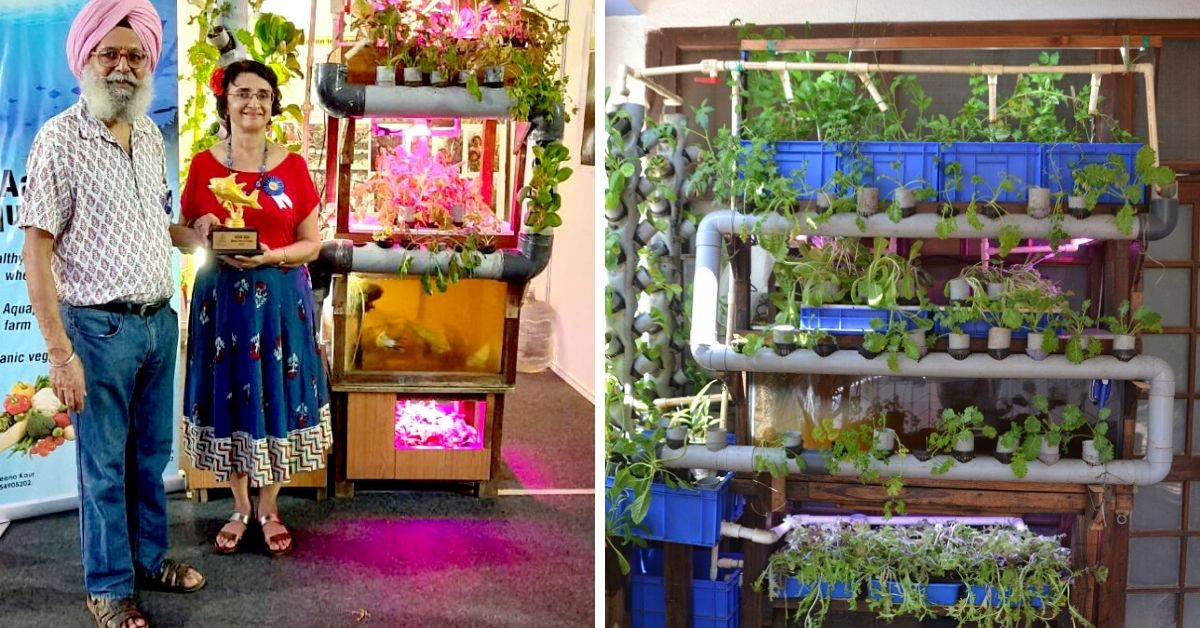
Goa-based Peter Singh is 74-years-old, and his wife Neeno Kaur is 65. They are a power couple, setting an example of how to be self-reliant with food, and at the same time, converting biodegradable waste into something useful.
On 185 square meters of greenhouse and rooftop garden, in their house at Dona Paula, Panaji, they produce 120 kilograms of fish a year and grow 3,000 plants consisting of vegetables and fruits.
For the last four years, they have been practising aquaponics at home, a combination of aquaculture (raising fish in tanks), with hydroponics (cultivating plants in water).
However, they do with a twist. “We do aquaponics with permaculture,” says Peter Singh, explaining his system to a bunch of enthusiasts earlier this year.
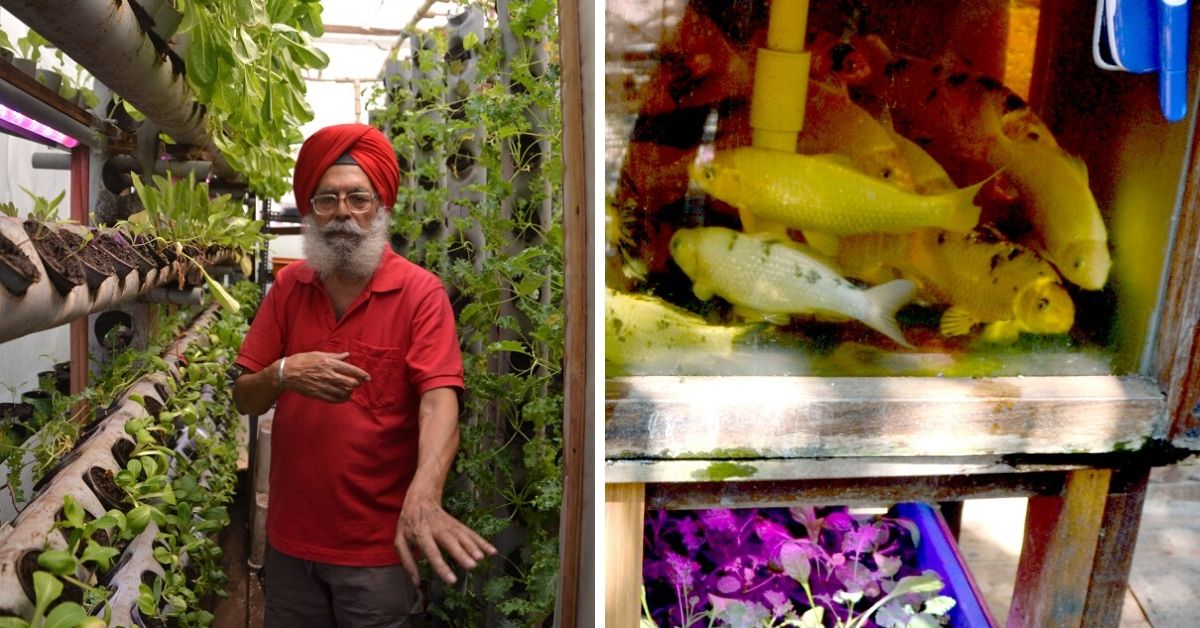
He adds, “We compost our kitchen and garden waste and use it in our aquaponics. Plants are potted in a layer of gravel, 1/3rd of coco peat and 2/3rd of compost. So, our plants get compost plus fish waste, which results in a higher yield. I don’t use any chemicals for this, and I am taking care of my waste and my food.”
One may wonder why they are doing it. For them, the answer is simple–they want to eat organic and be sure of how their food is grown.
Moreover, both have a background in agriculture.
“I was studying Mathematics at the Delhi University; the idea was to stay in Delhi, but then we thought of moving back to our farms in Jalandhar, Punjab. We worked on different forms of agriculture, in which different fruit and timber trees were planted, we did intercropping in the orchard of oilseeds and pulses, produced seeds for the national seed corporation, had a dairy farm, did beekeeping and even exported the honey,” explains Singh.
They moved to Goa seven years ago and found it difficult to source organic vegetables. The majority of the vegetables in the state come from the neighbouring city of Belgaum in Karnataka. So, they decided to grow their food in this unique way.
“As we have limited space in Goa, we experimented and discovered aquaponics. We downloaded papers from universities, and read about it. And came up with this model,” says Singh.
They opine that they are still experimenting and bring in changes accordingly. As they have the technical know-how and a background in farming, they are quite confident of their system.
How this system works
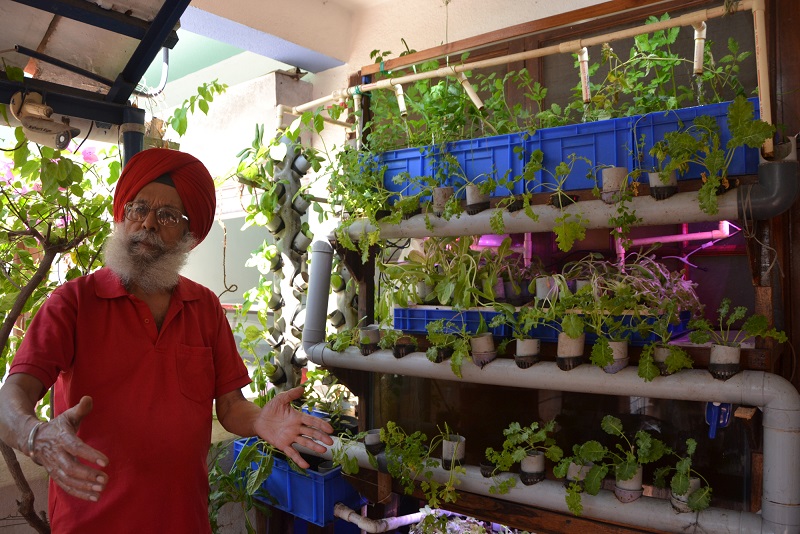
This system of aquaponics which involves the fish tank, NFT pipes, (Nutrient Film Technique) which are used to grow vegetables, water-pumps, and artificial grow lights, may look complicated. But Singh makes it easier to understand. He has also made a model of this system that can fit in any balcony or even in any corner of the living room.
“This unit of 2 ft by 6 ft and 6 ft high, with artificial lighting of 200 watts uses 250 litres of water and can grow 180 plants. One can grow lettuce, kale, bok choy or any other vegetable. One fish tank can sustain five kilograms of fish mass so that you can have ten fresh-water fish of ½ kg each,” elaborates Singh.
The system works mainly on electricity, water, and fish waste.
Singh explains, “In a fish tank, the fish waste is mainly ammonia. In this system, aerators circulate the water and create a current. The fish waste settles at the bottom, and the pipes take this waste into the bio-filter, which breaks the ammonia into nitrates and nitrites for plants to use.”
The water gets further filtered and goes back to the fish. It also has aeroponic towers which work as the nursery of plants. It is also a space-saving system as it is vertical.
“Because of heavy nitrogen, green vegetables grow very well. We have lettuce, bok choy, and celery. Also, this system uses 10 per cent of water used in traditional soil-based farming, as water is constantly getting re-used. The only loss is in the evaporation. There’s no need of watering, no weeding, one only has to feed the fish twice a day,” says Neeno Kaur.
The entire system has three fish tanks on the ground floor. One is of 3,000 litres of water; second is 1,500 litres, and the third is 4,000 litres. They raise three types of fresh-water fish—rohu, catla, and chonak or sea bass. If one does not eat fish, Singh suggests using ornamental fish.
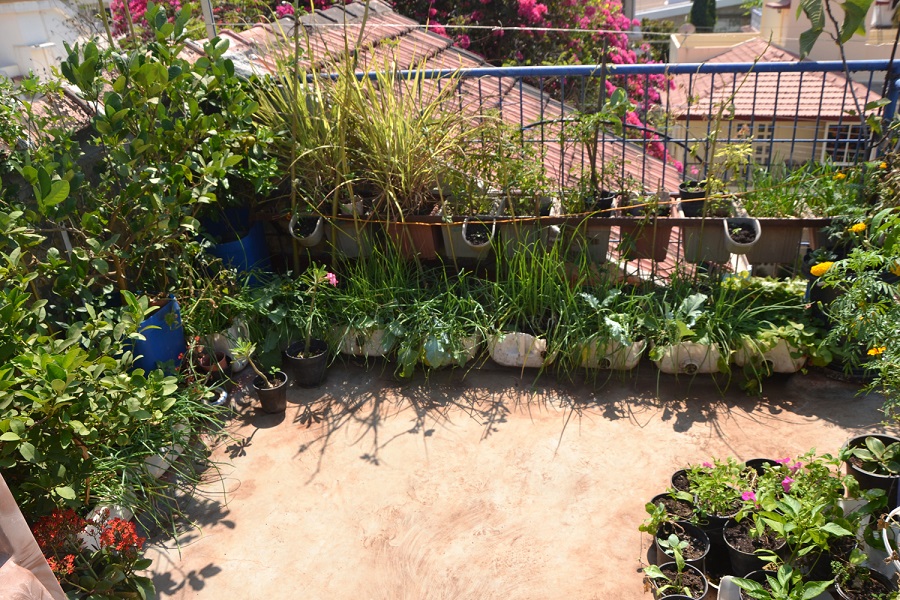
On their roof, they have a greenhouse of 12ft by 24ft, which has 2,000 plants. The greenhouse in the back garden is 6 ft by 16 ft and has 500 plants. A roof-top garden has 25 fruit trees, 300 onions, and an assortment of chillies, lemons, tomatoes, aloe, chives, creepers like ivy gourd, bottle gourd, cucumber, bitter gourd, ladyfinger, brinjal.
Along a boundary on the ground floor, they have mango, banana, and papaya. They also have an air-conditioned tunnel of 8 ft by 12 ft in their greenhouse, with 1,000 plants of lettuce, kale, bok choy, basil, parsley, cabbage, and broccoli. For the whole system, they spend around Rs 14,000 per month.
The aquaponics system doesn’t require cleaning of water as water gets filtered in the process. And all the fittings are made by Singh himself. He has also part-time workers for about six hours a day. He adds, “We spend Rs 6,000 on electricity, Rs 4,000 on feeding the fish and another Rs 4,000 on labour.”
They won the first prize for Most Innovative Stall at the Aqua Goa Mega Fish Festival 2020 held in February.
Agriculture expert from Goa, Miguel Braganza opines, “Peter Singh’s aquaponics is good for those who can afford it as the basic cost of the unit is Rs 30,000. Also, it is ideal for those who eat salads and continental cuisine.”
Regarding the cost, Singh states that it is high “because we pump water from the ground floor to the greenhouse on the roof. If it is on the same floor, this is much lower.”
They also have plans for solar panels and making fish feed at home to be self-sustainable. He adds, “If we automate the system, and put in solar power, then costing will go down substantially. We are also working on growing feed for fish. So our whole system becomes self-dependent.”
However, they are also trying to monetise from this system, by conducting two-day training programmes priced at Rs 5,000. Singh adds, “We also custom design and help set up aquaponics systems, of any scale, from small home systems to commercial systems, charging 10 per cent of the capital cost for the design.”
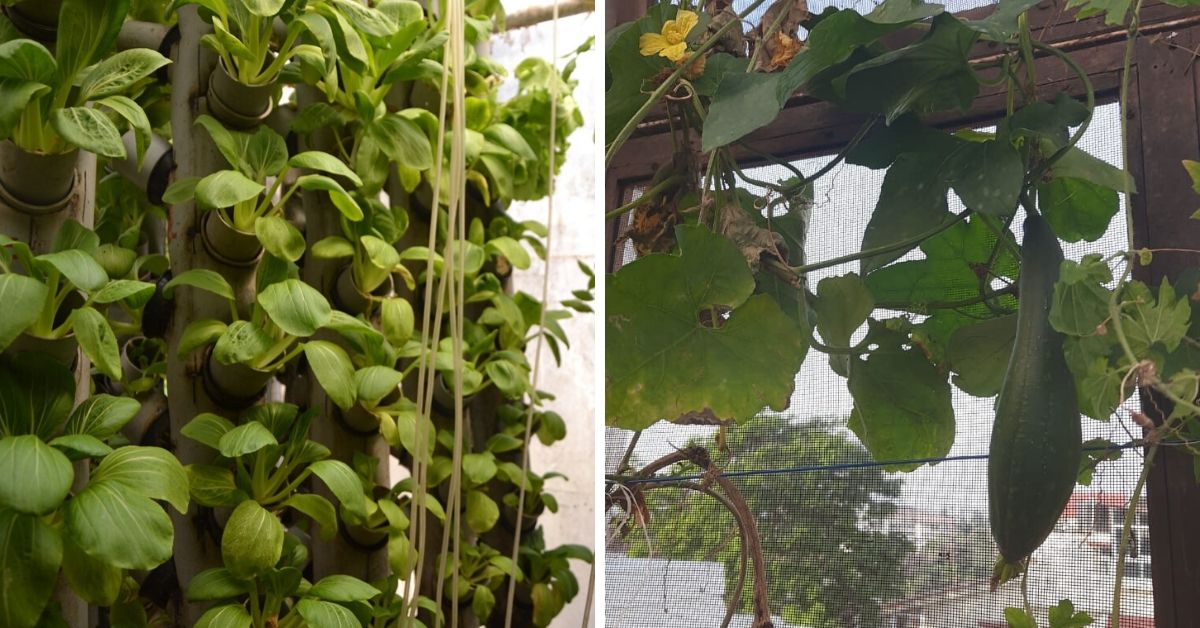
Recently, they started selling these vegetables from their home. A basket contains two bunches of lettuce, a baby bok choy, three sticks of celery, sprigs of parsley, basil and a small bunch of mint, priced at Rs 100. They will also add kale and Swiss chard to it. From next month, their air-conditioned model will produce about 300 packs of greens a month at Rs 120 each.
Singh and Kaur are hopeful that more people will learn from this system and eat healthy food as it is the need of the hour.
He concludes, “This method is independent of the weather, rain, hail, and sun; it is protected from predators and is the future of agriculture. It doesn’t need land, soil, or chemicals, and produces vegetables and fish wherever you are.”
Also Read: Experts Answer: Can a Hydroponics Farm Be a Good Business? Here’s How!
This shows that aquaponics could be next best thing in agriculture due to urbanisation and loss of agricultural land. It is estimated that the market of aquaponics will grow with the awareness to eat healthy food.
According to a report by Assocham and Ernst & Young, organic products market in India have been growing at a CAGR (Compound Annual Growth Rate) of 25 per cent, expected to touch ₹10,000-₹12,000 crore by 2020 from the current market size of ₹ 4,000 crore. As aquaponics is a part of the organic market, the future looks bright for this new-age form of agriculture.
During the current nationwide lockdown to tackle COVID-19, Peter Singh is selling their produce once a week from their home by maintaining social distancing. He says, “We slowed down the sale of our produce in the first week, and worked out a weekly production schedule, which includes a weekly harvest and transplantation. This means we will be able to supply every week all year round.”
(Written by Arti Das and Edited by Shruti Singhal)
Like this story? Or have something to share?
Write to us: [email protected]
Connect with us on Facebook and Twitter.
If you found our stories insightful, informative, or even just enjoyable, we invite you to consider making a voluntary payment to support the work we do at The Better India. Your contribution helps us continue producing quality content that educates, inspires, and drives positive change.
Choose one of the payment options below for your contribution-
By paying for the stories you value, you directly contribute to sustaining our efforts focused on making a difference in the world. Together, let’s ensure that impactful stories continue to be told and shared, enriching lives and communities alike.
Thank you for your support. Here are some frequently asked questions you might find helpful to know why you are contributing?


This story made me
-
97
-
121
-
89
-
167











